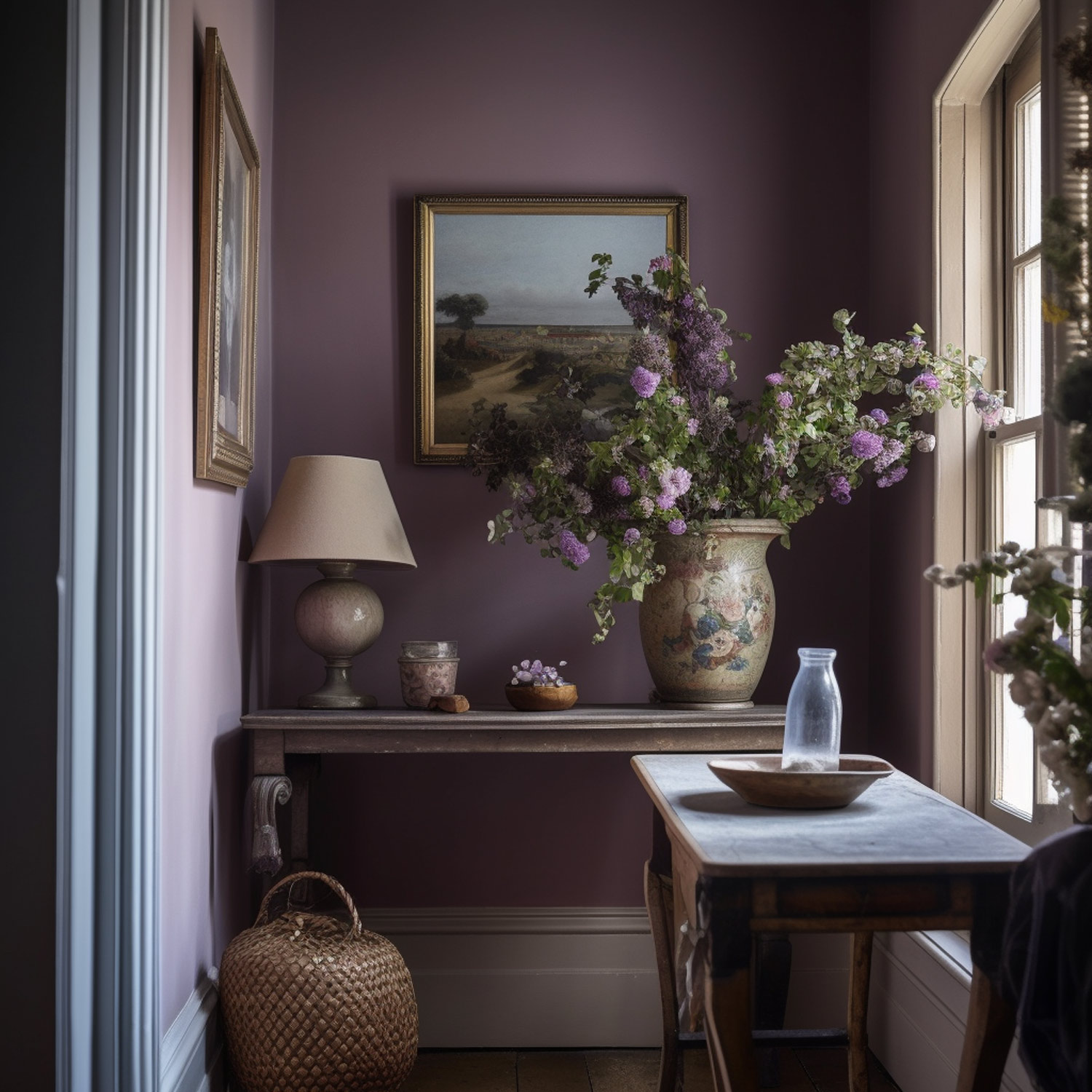Purple, a paint colour often associated with royalty, luxury, and creativity, is a versatile and captivating option for interior design. In this article, we’ll explore the history of purple wall paints, discuss why they have become popular, and examine the various shades of purple, from light to dark. We’ll also delve into the emotions evoked by this vibrant colour and discuss trends in its use. Finally, we’ll highlight the pros and cons of incorporating purple into your home decor.
The History of Purple Wall Paints
The use of purple dates back to ancient civilisations, with the earliest known purple dye traced to the Minoan civilisation around 1900 BCE. The colour was highly prized due to the rarity and expense of the dye, which was derived from sea snails. This association with luxury and royalty has persisted throughout history, with purple often used to adorn palaces and other regal settings.
Why Choose Purple for Your Home?
Purple is a unique and versatile colour that can evoke feelings of sophistication, creativity, and tranquillity. It can create a sense of luxury and opulence in a room or inspire a calming and soothing atmosphere. Purple’s wide range of shades allows it to suit various styles and preferences, making it an appealing choice for many homeowners and designers.
Light Purple
Light purple shades, such as lavender and lilac, are known for their calming and soothing properties. They’re perfect for creating a serene atmosphere in spaces like bedrooms, nurseries, or meditation rooms. Light purple can also make a room feel more spacious, and when paired with white or neutral shades, it creates a delicate and elegant aesthetic.
Pros:
- Calming and soothing
- Makes rooms feel more spacious
- Creates a delicate and elegant aesthetic
Cons:
- May not be suitable for high-traffic areas
Dark Purple
Darker shades of purple, like eggplant or deep violet, offer a rich and luxurious vibe. These colours are perfect for adding a touch of drama and opulence to a space. Dark purple shades work well as accent walls or in rooms with plenty of natural light, as they can be overpowering in small, dimly lit spaces.
Pros:
- Rich and luxurious
- Adds drama and opulence to a room
Cons:
- Can be overpowering in small or dimly lit spaces
- May be too bold for some tastes
Shades of Purple
There’s a purple shade for every preference, from pale and muted tones to deep and saturated hues.
Some popular shades include:
- Plum: A warm, inviting shade that works well in traditional and contemporary spaces
- Amethyst: A vibrant, jewel-toned purple that adds a touch of glamour and luxury
- Wisteria: A soft, dusty purple that pairs well with rustic and industrial design elements
- Periwinkle: A subtle, blue-toned purple that adds a sense of tranquillity and serenity
The Psychology of Purple
Purple is often associated with feelings of creativity, luxury, and spirituality. It has been found to stimulate the imagination and foster a sense of introspection and contemplation. However, reactions to purple can vary depending on the individual and the shade in question. While some may find light purple to be soothing and inviting, others may see it too sombre.
Trends in Purple Wall Paints:
In recent years, purple has experienced a resurgence in popularity, with shades like lavender and deep violet becoming trendy choices for interior design. The colour has been embraced in various design styles, from minimalist and Scandinavian-inspired spaces to eclectic, bohemian settings.
Read more: The Most Popular Interior Wall colours for Your Home
Combining Purple with Other colours
One of the keys to successfully using purple wall paint is finding the right complementary colours.
Purple pairs well with various shades, including:
- White and grey: Creates a clean, sophisticated look
- Navy and black: Adds depth and contrast for a modern edge
- Green and turquoise: Offers a fresh, lively feel reminiscent of nature
- Gold and brass: Brings a touch of glamour and luxury
Pros and Cons of Using Purple Wall Paints
Pros:
- Versatile, with shades suitable for every taste and style
- Evokes a range of emotions, from calming to luxurious
- Works well with a variety of complementary colours
- Has a rich history and association with luxury, creativity, and spirituality
Cons:
- May be seen as too sombre by some individuals
- Bold shades may be overpowering in small or dimly lit spaces
- Light purple shades may not be suitable for high-traffic areas
Purple wall paint is a timeless and versatile choice for interior design, offering a wide range of shades that can evoke emotions from calming and soothing to rich and luxurious. With a rich history and association with luxury, creativity, and spirituality, it’s no surprise that purple continues to be a popular choice for homeowners and designers alike. By understanding the various shades of purple and how they can be combined with complementary colours, you can create a space that is truly unique and reflective of your personal style.
A Room-by-Room Guide to Incorporating Purple Wall Paints in Your Home
Purple is a captivating and versatile colour that can be successfully incorporated into various rooms throughout your home. This room-by-room guide will help you understand how to use purple wall paints in your kitchen, lounge, living room, bathroom, hallway, and stairway, creating a cohesive and stylish interior.
Purple paint for the Kitchen
Purple can bring a touch of sophistication and creativity to a kitchen. Light purple shades can create a bright and airy feel, while bolder shades can add a pop of colour that energises the space. Pair purple with white or grey cabinetry for a clean, modern look, or combine it with wood and brass accents for a warm and inviting atmosphere.
Purple paint for the Lounge
In a lounge area, purple can create a sense of luxury and relaxation. Opt for a muted or dusty purple to create a cosy and sophisticated vibe, or choose a darker shade like eggplant for a more dramatic and opulent feel. Complement the purple with plush, neutral-toned furniture and accent pieces to maintain balance and elegance.
Purple paint for the Living Room
Purple can make a living room feel welcoming and comforting. A soft, pastel purple works well for creating a soothing atmosphere, while a more vibrant shade can add personality and energy to the space. Mix purple with other colours, like navy blue or emerald green, for a rich and contrasting colour scheme, or pair it with lighter neutrals for a harmonious and calming aesthetic.
Purple paint for the Bathroom
Purple can be a refreshing and rejuvenating choice for a bathroom. Light shades of purple can make the space feel clean and spacious, while a bold shade can create a striking and invigorating environment. Combine purple with white tiles and fixtures for a classic and timeless look, or experiment with patterned tiles and unique accessories for a more eclectic and personalised touch.
Purple paint for the Hallway
Hallways can benefit from the warm and inviting qualities of purple. Light purple shades are ideal for creating a bright and welcoming entrance, while a bolder purple can make a statement and add visual interest. Pair purple with neutral-toned flooring and artwork to keep the space feeling open and uncluttered.
Purple paint for the Stairway
In a stairway, purple can add a touch of elegance and charm. A soft or dusty purple is perfect for creating a gentle and soothing transition between floors, while a vibrant shade can add an unexpected pop of colour that draws the eye. Consider using purple on the walls, handrails, or stair risers, and coordinate it with complementary colours and patterns in nearby rooms for a cohesive and stylish look.
Conclusion
Purple wall paints can be successfully incorporated into various rooms throughout your home, creating a wide range of atmospheres and styles. By considering the function and desired mood of each space, you can choose the perfect shade of purple that enhances both the room’s aesthetics and the overall flow of your home. From kitchens and living rooms to hallways and stairways, purple can make a stunning and versatile addition to any interior design scheme.

Hi! I’m Chris, the founder of The Organic & Natural Paint Co, and I’m focused on the education and promotion of natural non toxic alternatives to chemical laden everyday products that we just take for granted. We have a choice, and I want to raise awareness of alternative products that don’t actually harm us!
This company is my way of pushing the awareness of better indoor air quality, something that I am personally passionate about due to my own children’s breathing medical conditions. I just couldn’t paint with big brand standard petrochemical paint any longer and wanted another solution.
Read more: About me
Twitter: NaturalPaintCo
Instagram: cleanairclubofficial


